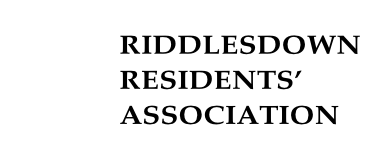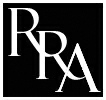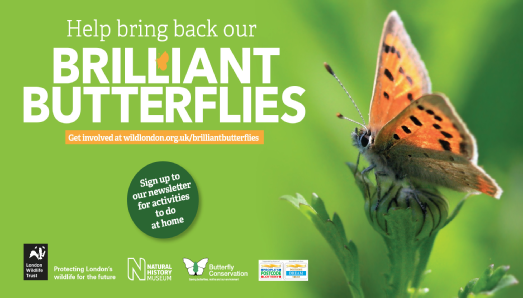


REPORTS FROM THE RECORDER & ADVERTISING RATES
The Riddlesdown Recorder
On Line
PLANNING APPLICATIONS
PLANNING ADVICE ON
USEFUL LOCAL INFORMATION & LINKS
Information on Local Healthcare, Leisure,
Transport -
Community Page
(Things to do, join and help with)
ABOUT THE
RIDDLESDOWN
RESIDENTS’ ASSOCIATION
ABOUT RIDDLESDOWN
AND ITS COMMON

Butterfly Conservation on Riddlesdown Open Space
Brilliant Butterflies blog
New 9/12/20
Information on this link, about the latest project blog (from Steve Bolton) and creating 16 new butterfly banks across Croydon including planting at Riddlesdown Common with local volunteers.
April 2020
Steve Bolton, Project Officer at Butterfly Conservation was due to speak at the RRA AGM on 13 May 2020 but the AGM was cancelled due to the coronavirus pandemic.
However we have been sent this information:
Sign up to the #BrilliantButterflies newsletter for lots of great wildlife content and fun family activities to do at home. The project is working with local communities to create wildflower habitat in greenspaces across South Croydon and Bromley. See link for more information: https://www.wildlondon.org.uk/brilliant-

Information received from Steve Bolton, Project Officer for
Brilliant Butterflies -
Brilliant Butterflies: why record butterflies?
London Wildlife Trust, the Natural History Museum and Butterfly Conservation are working together creating and restoring chalk grassland to come alive with butterflies and wildflowers in south Croydon and Bromley. We will be working with local residents, schools and landowners to host nature friendly events and make new homes for butterflies by creating over 40 areas of chalk grassland habitat between Downe, New Addington and Coulsdon.
As part of my role as the Butterfly Conservation Project Officer I have enjoyed getting out and about recording butterflies and moths across the project area. A butterfly or moth record consists of a few key pieces of information including the species seen, number of individuals, site location and date. This work supplements existing data, collected by volunteers, by ensuring we have up to date records on both the project nature reserves and surrounding greenspaces. The records can then be analysed to determine which species are in decline, where to find them and to help identify opportunities for species expansion. New and improved chalk grassland habitat will help support the expansion of threatened butterfly species, such as the small blue, by boosting populations on nature reserves and by creating new habitat or ‘stepping stones’ between nature reserves and greenspaces.
Small Blue

Where new habitat is created nearby an existing nature reserve butterflies and moths will begin to colonise and start a new breeding population in time. For example, we are in discussion with the Friends of Sanderstead Recreation Ground about the potential for creating new areas of wildflower habitat on the recreation ground to support butterflies and moths that will colonise from Riddlesdown Common.
Records collected this year will provide baseline information which can be compared to records in future years when we expect to see a greater variety and abundance of butterflies across the project area. Habitats across London support over 40 of the UK’s 59 butterfly species but many are in decline. There are a number of methods of recording butterflies and moths including butterfly transects, recording presence of butterflies using iRecord and moth trapping. A butterfly transect is the best way of monitoring butterfly populations in the long term by walking a set route, often in a nature reserve or park, every week between April and September and recording all the butterflies seen. Population trends can then be determined when comparing years.
Recording the presence of butterflies in gardens, parks and greenspaces provides valuable information about their status and the health of the environment. Butterflies and moths are good indicators of environmental change and the quality of our countryside and urban landscape. They are easy to record and identify and can be used as a barometer for the fate of many thousands of other, less well-
The iRecord Butterflies app is a great tool for both identifying and recording butterflies in any location from your garden to your local greenspace and will help paint a picture of local butterfly distribution. Its great fun too as different species come and go throughout spring and summer and occasional migrant butterflies appear like the beautiful painted lady. See picture.

The Big Butterfly Count is an annual UK-
Butterfly Recording

In addition to recording butterflies I have also been recording moths using a light trap. Moths are amazing, beautiful, diverse, and they are all around us. Many of the nocturnal moths are attracted to light where they can be easily identified and recorded the following morning before being safely released. The records provide vital resources to underpin nature conservation. National moth week runs from July 18 – 26 and where many events across the country provide an opportunity to celebrate, learn, observe and contribute scientific data about moths.
Privet hawk-

We have not been able to run the planned butterfly identification and moth trapping workshops this summer but please look out for these next spring if you would like to learn more. However, with the recording methods I have mentioned you can become a ‘Citizen Scientist’ and help contribute towards the conservation butterflies and moths this summer. You can find more information online at
https://www.wildlondon.org.uk/brilliant-
or follow Steve Bolton on Twitter; @bc_bolton